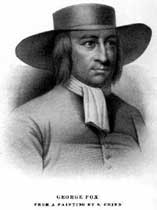Post by Charles Hankin

[Ed. note: Hankin is responding to a series of posts about the exhibition, “The Lost Meeting” at Abington Art Center. For more, see these posts in the thread: Roberta‘s original post, Hankin‘s post on Quakerism, Roberta’s email back and forth with spurse member Paolo Bartolli and photographer Zoe Strauss‘s comment.)
Boy am I now confused! Conflict can be mediated which is a small part of the history of Quakers.
Much like the image of the old Quaker Oats man it seems that “Lost Meeting” is dealing with the superficial. What are Quaker objects? There are no Quaker religious icons and plainness is only a distant remnant of what Quakerism was. (top image is Quaker Oats man, a trademarked image owned by Pepsico)
To mediate is an action between parties in dispute. The differences between the Hicksite and Orthodox Friends were spiritual and lead to removal not mediation. The reunification was and is about acceptance.
What concerns me is the use of the term “abandoned Meeting” or “Lost Meeting”. This faux anthropological study leaves the false impression that Quakers walked away from the building with no reason or purpose.
If the Art Center really respected the Quaker idea of Meetinghouse they would fix it up and use it for classes or meetings. If they want to respect the Quaker historical aspects of the Meetinghouse they could maintain it as a historical restoration. (time capsule) It feels like a misuse to try to interpret it through “art”.

The exhibit, which I still haven’t had time to experience, sounds like a misleading conception of what Quakerism is. It might be Shaker, Amish, Mennonite or Brethren all historically plain sects. Quakers were merchants and business owners who had fine china, cut glass, fine furniture, pianos, paintings, and many goods sold in Wanamakers, Strawbridges and Bailey Banks and Biddle. The image of the Quaker on the oats package represented the primary value of the sect- honesty. The spiritual values can be found in the teaching of Jesus not in a presumed church dogma. Common objects are not sacred and have not in my experience had any spiritual relevance to my faith. Living simply with respect for others has everything to with stewardship. (image is of George Fox, founder of Quakerism)
The question remains, what relationship do the activities occurring within the building have to the spiritual revelation of God within all? Or is it just a pastiche of the past?
Peace. Charlie
–Artist Charles Hankin is a regular contributor to Artblog.









